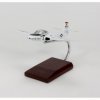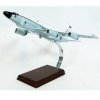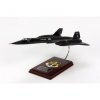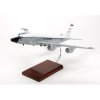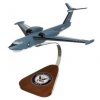McFarlane SportsPicks is no stranger to recreating some of the NBA’s greatest players as highly detailed action figures and their 20th lineup is no exception.
WARNING: CHOKING HAZARD - Small parts & small ball. Not for children under 3 years.
Pre-Order, Sold Out Available: November
|
"The Cessna T-37 is an Air Force's dual-engine and dual-purpose jet. It is also popularly known in various forms: Dragonfly, Tweety Bird, Tweet, or Super Tweet. The A-37 combat version was developed from the T-37 trainer, which was the standard jet trainer form the mid-'50s into the '70s. As A-37, it served with distinction in an attack role during the Vietnam War and, in its larger role, flew for decades as a primary trainer for the USAF. A-37 provided a wide range of services in the air forces of other nations. The first T-37 Tweet flew in October 1954. Fifty-two years after its first flight, the T-37 is still serving the U.S. military, giving the United States Air Force-trained primary pilot training students the necessary experience needed before moving on to the Northrop T-38 Talon, Beechcraft T-1A Jayhawk, Bell UH-1 Huey, United States Navy Beech T-44 Pegasus, or other advanced Navy, Marine Corps or Allied trainers. The T-37A version of the Tweety Bird made its first flight in 1955 and went into service with the Air Force in June 1956. The production T-37A was similar to the XT-37 prototypes, except for minor changes to fix problems revealed by the flight test program. The USAF began cadet training in the T-37A during 1957. The Air Force ordered 444 T-37As, with the last produced in 1959. During 1957, the US Army evaluated three T-37As for battlefield observation and other combat support roles, but eventually procured the Grumman OV-1 Mohawk for the mission instead. The Air Force liked the T-37A, but felt it was underpowered. As a result, the service ordered an improved version, the T-37B, with uprated J-69-T-25 engines. The new engines provided about 10% more thrust and better reliability. Improved avionics were also specified for the new variant. "
Scale: 1/48 scale model
Wing Span: 8.5
Length: 7.5
CT37T
|
"The USAF RC-135V/W RIVET JOINT surveillance aircraft are equipped with an extensive array of sophisticated intelligence gathering equipment enabling military specialists to monitor the electronic activity of adversaries. Also known as ""RJ"", the aircraft are sometimes called ""hogs"" due to the extended ""hog nose"" and ""hog cheeks"". RIVET JOINT has been widely used in the 1990's -- during Desert Storm, the occupation of Haiti, and most recently over Bosnia. Using automated and manual equipment, electronic and intelligence specialists can precisely locate, record and analyse much of what is being done in the electromagnetic spectrum. The fleet of 14 RIVET JOINT aircraft increased to 15 in late 1999 with the addition of a converted C-135B. The jet's conversion cost about $90 million. The Rivet Joint fleet is currently undergoing significant airframe, navigational and powerplant upgrades which include re-engining from the TF-33 to the CFM-56 engines used on the KC-135R and upgrade of the flight deck instrumentation and navigational systems to the AMP standard. The AMP standard includes conversion from analog readouts to a digital glass cockpit configuration. The Air Force plans to spend at least $1.4 billion to keep the RC-135 Rivet Joint (RJ) fleet flying through 2018. The service also plans to modify a recently retired Air National Guard KC-135 tanker, turning it into the Air Forces 17th RJ signals-intelligence aircraft. "
Scale: 1/100 scale model
Wing Span: 16.63
Length: 16.75
CRC135RJT
|
"The RC-135S Cobra Ball is a MASINT aircraft designed to observe ballistic missile flights at long range. The RC-135S was used primarily as a traditional mission in the past against Russia. It performed numerous aerial reconnaissance missions of national-level significance. The aircraft is equipped with special optical instruments. The RC-135S Cobra Ball is an extensively modified C-135. It tracks missile systems for treaty verifications and has a growing role in theater missile defense. Cobra Ball's specialized employs sensitive telescopic monitoring device, advanced optics and infrared sensors, providing national and theater command authorities with intercontinental ballistic missile treaty verification data and Theater Air Defense warning. There are four RC-135S in service and they are part of the 55th Wing, 45th Reconnaissance Squadron based at Offutt Air Force Base, Nebraska. The RC-135S was originally assigned to Shemya and was used for observation of ballistic missile tests on the Kamchatka peninsula in conjunction with Cobra Dane and Cobra Judy. "
Scale: 1/100 scale model
Wing Span: 16
Length: 16.5
CK135ST
|
"The RC-135U Combat Sent is an electronic intelligence reconnaissance and surveillance aircraft in use by the United States Air Force (USAF). It is employed as a Scientific and Technical ELINT Collection System and designed to collect technical intelligence on adversary systems. The Combat Sent provides strategic electronic reconnaissance information to the president, secretary of defense, Department of Defense leaders, and theater commanders. The RC-135U is equipped with an aerial refueling system, giving it an unlimited flying range. The navigation equipment incorporates ground navigation radar, a solid state Doppler system, and an inertial navigation system that combines celestial observations and Global Positioning System data. Communication equipment includes high frequency, very high frequency, and ultra high frequency radios. The aircraft has distinctive antennae arrays on the “chin” and wing tips, large cheek fairings, and an extended tail. Its crew consists of two pilots, two navigators, two airborne systems engineers, and a minimum of ten electronic warfare officers, also known as “Ravens,” and six or more electronic, technical, and area specialists. There are only two Combat Sents in the USAF, both assigned to the 55th Wing at Offutt Air Force Base, Nebraska. The RC-135U has with a wide array of commercial off-the-shelf and proprietary hardware and software. Its current configuration allows for both manual and automatic analysis of electronic signals. It locates and identifies foreign military land, naval and airborne radar signals to collect and examine each system, providing analysis for warfighters. Collected data is recorded for future reference or for extensive analysis by electronic systems theorists. Any information gathered from the data will help determine detailed operating characteristics and capabilities of foreign systems. Evasion techniques and equipment are then developed from this knowledge that will detect, warn of, or defeat these electronic systems. The Combat Sent deploys worldwide and is employed in peacetime and contingency operations. "
Scale: 1/100 scale model
Wing Span: 16.25
Length: 17
CRC135UT
|
"S-3B aircraft manned and operated by an aircrew of four and is tasked to provide Anti-Submarine Warfare (ASW) and Anti-Surface Warfare (ASUW), surveillance and intelligence collection, electronic warfare, mine warfare, coordinated search and rescue and fleet support missions, including air wing tanking. Between July 1991, all east coast S-3A aircraft were modified by a contractor field team at the Naval Air Station (NAS) Cecil Field, Florida. In March 1992, west coast S-3A aircraft were modified to the S-3B aircraft configuration and was completed in September 1994. In 1995, Communications Control Groups (CCGs) were installed in approximately 40 of the S-3B aircraft at NAS North Island. In MArch 1997, installation of the remaining CCGs began and is scheduled for completion in the first quarter of Fiscal Year 2000. The S-3B aircraft is in Phase III, Production, Fielding, Deployment and Operational Support phase of the weapon System Acquisition Process. In fiscal year 1992, ten aircraft S-3B squadrons were reduced to six. In 1993, aircraft assets for deployed squadrons were increased to eight, to meet increased operational requirements caused by retirement of the A-6E from the Navy inventory. All S-3B squadrons are currently configured and manned for eight aircraft. The Underwater Warfare Systems (USW) have been removed from the S-3B Viking aircraft providing an ideal opportunity for improved technologies to be developed in the S-3B aircraft. "
Scale: 1/72 scale model
Wing Span: 9
Length: 11.75
CS3TR
|
"The Lockheed SR-71 is an advanced, long range, Mach 3 Strategic reconnaisance aircraft developed from the Lockheed YF-12A and A-12 aircraft by the Lockheed Skunk works. The SR-71 was considered the world's fastest and highest flying piloted aircraft 30 years ago up till now. The SR-71 was unofficially named as Blackbird and was called Habu (snake) by its crews. the SR-71 was the first aircraft shaped to reduce its radar cross selection, although its radar signature could be tracked by contemporary systems unlike later stealth aircraft. The defensive feature of the SR-71 aircraft is its high-speed and operating altitude. the SR-71 has a predecessor, the A-12 OXCART which was designed for the CIA bu Kelly Johnson at the Lockheed Skunk Works and he later renamed it ""Archangel"" for its design, but many documents use Johnsn's preferred name for the aircraft, the ""Article"". The USAF had planned to redesignate the A-12 aircraft as the B-71 which was the B-70 Valkyrie's successor. The public disclosure of the program and its and renaming came as a shock to everyone at the Skunk Works and to Air-Force personnel involved in the program. Although the predecessor A-12 first flew in 1962, the first flight of an SR-71 took place on december 22, 1964 at the airforce plant 42 in Palmdale, california. The first SR-71 to enter service was delivered to the 4200th Strategic Reconnaisance Wing at Beale Air Force Base, California in January 1966. A total of 32 SR-71 aircrafts were built. "
Scale: 1/63 scale model
Wing Span: 10.5
Length: 20.25
CS71TS
|
"T-1 Jayhawk is a medium-range, twin-engine jet aircraft used by the United States Air Force's Air Education and Training Command for advanced pilot training. In January 1992, the first T-1A was delivered to Reese Air Force Base, Texasand in 1993, student training began. Since the late 1950's, Air Force undergraduate pilot training students have trained in two aircraft, the T-37 Tweet and the T-38 Talon, with the former as the primary trainer and the latter was the advanced trainer. In 1993, with the introduction of specialized undergraduate pilot training, the T-37 still continued to be the student's primary training aircraft, and later, the T-6 Texan II, but the advanced phase was tailored for students' follow-on assignments. Advanced training is conducted in the T-38 for students going to bombers and fighters and the T-44 or TC-12B for students who are selected for airlift. The T-1A incorporates two Pratt and Whitney JT15D-5 turbofan engines. The T-1A has a crew for 3; one for the instructor pilot and two for student pilots. It has a maximum speed of 468 knots and a range of 2,100 nm. The T-1A is used at Columbus AFB, Miss., Laughlin AFB, Texas and Vance AFB, Okla and is also used at Randolph AFB, Texas, for training instructor pilots. "
Scale: 1/48 scale model
Wing Span: 10.88
Length: 12
CT1JT
|
"The Boeing KC-135 Stratotanker is a United States aerial refueling tanker aircraft. It has been in service with the United States Air Force since 1957. Besides its primary role as an inflight aircraft refueler, the KC-135, designated NKC-135, has assisted in several research projects at the NASA Dryden Flight Research Center at Edwards Air Force Base, California. One such project occurred between 1979 and 1980 when special wingtip ""winglets"", developed by Richard Whitcomb of the Langley Research Center, were tested at Dryden, using an NKC-135A tanker loaned to NASA by the Air Force. Winglets are small, nearly vertical fins installed on an aircraft's wing tips. The results of the research showed that drag was reduced and range could be increased by as much as 7 percent at cruise speeds. Winglets are now being incorporated into most new commercial and military transport jets, as well as business aviation jets. NASA also has operated several KC-135 aircraft (without the tanker equipment installed) as their infamous Vomit Comet zero-gravity simulator aircraft. The longest-serving (1973 to 1995) version was KC-135A 59-1481, named Weightless Wonder IV registered N930NA. "
Scale: 1/100 scale model
Wing Span: 16
Length: 16.5
CK135ET
Pre-Order! Available: November
|
"The RC-135 is a reconnaissance aircraft used to support theater and national level consumers with near real-time on-scene intelligence collection, analysis and dissemination capabilities. The RC-135 is an extensively modified C-135, allowing the mission crews to detect, identify and geolocate signals throughout the electromagnetic spectrum. The current fleet of the RC-135 was initially employed by Strategic Air Command, satisfying nationally tasked reconnaissance requirements. The RC-135U Combat Sent is a reconnaissance aircraft used by the United States Air Force and was designed to collect technical intelligence on adversary systems. Currently, only two Combat Sents in the USAF, both based at Offutt AFB, Nebraska under the 55th Wing. The RC-135 participated in every armed conflict which involves U.S. assets during its tenure. The aircraft supported operations in Vietnam, the Mediterranean for Operation El Dorado Canyon, Grenada for Operation Urgent Fury, Operation Just Cause, Operations Deliberate Force and Allied Force and Southwest Asia for Operations Desert Shield, Desert Storm, Enduring Freedom and Iraqi Freedom. All RC-135s are assigned to Air Command and is permanently based at Offutt Air Force Base, Nebraska. The RC-135 is operated by the 55th Wing using various forward operating locations worldwide. "
Scale: 1/100 scale model
Wing Span: 16.25
Length: 17
CK135UT
|
"The USAF RC-135V/W RIVET JOINT surveillance aircraft are equipped with an extensive array of sophisticated intelligence gathering equipment enabling military specialists to monitor the electronic activity of adversaries. Also known as ""RJ"", the aircraft are sometimes called ""hogs"" due to the extended ""hog nose"" and ""hog cheeks"". RIVET JOINT has been widely used in the 1990's -- during Desert Storm, the occupation of Haiti, and most recently over Bosnia. Using automated and manual equipment, electronic and intelligence specialists can precisely locate, record and analyse much of what is being done in the electromagnetic spectrum. The fleet of 14 RIVET JOINT aircraft increased to 15 in late 1999 with the addition of a converted C-135B. The jet's conversion cost about $90 million. The Rivet Joint fleet is currently undergoing significant airframe, navigational and powerplant upgrades which include re-engining from the TF-33 to the CFM-56 engines used on the KC-135R and upgrade of the flight deck instrumentation and navigational systems to the AMP standard. The AMP standard includes conversion from analog readouts to a digital “glass cockpit” configuration. The Air Force plans to spend at least $1.4 billion to keep the RC-135 Rivet Joint (RJ) fleet flying through 2018. The service also plans to modify a recently retired Air National Guard KC-135 tanker, turning it into the Air Force’s 17th RJ signals-intelligence aircraft. "
Scale: 1/100 scale model
Wing Span: 16.63
Length: 16.75
CK135VT
|
"The KC-10A Extender is an air mobility command advanced tanker and cargo aircraft designed to provide increased global mobility for US armed forces. Its primary mission is aerial refueling but it is capable of simultaneously carrying fighter support personnel and equipment on overseas deployments. It can also transport litter and ambulatory patients using patient support pallets during aeromedical evacuations. The KC-10A was the second consecutive McDonnell Douglas transport aircraft to be selected by the US Air Force following the C-9 Nightingale. The KC-10A was derived from the civilian DC-10 airliner and entered service in 1981. Although it retains 88 percent of the DC-10, it has additional systems and equipment necessary for its Air Force mission. These include military avionics, seated aerial refueling operator station, and aerial refueling receptacle and satellite communications. It also has three more large fuel tanks. Using either an advanced aerial refueling boom, or a hose and drogue centerline refueling system, the KC-10A can refuel a wide variety of US and allied military aircraft within the same mission. The aircraft is equipped with lighting for night operations. During Operations Desert Shield and Desert Storm in 1991, the KC-10A provided in-flight refueling to aircraft from the US armed forces and other coalition forces. In-flight refueling was vital to rapid airlift of materiel and forces in the early stages of Desert Shield. Furthermore, the KC-10A, along with the KC-135, transported tons of cargo and thousands of troops in support of the Persian Gulf buildup. The KC-10A and the KC-135 conducted approximately 51,700 separate refueling operations and delivered 475 million liters of fuel without missing a single schedule. "
Scale: 1/150 scale model
Wing Span: 13
Length: 14.5
CKC102T
|
"The KC-10A version of the Extender had its first flight on July 12, 1980. The aircraft is an Air Mobility Command advanced tanker and cargo aircraft designed to provide increased global mobility for U.S. armed forces. The first KC-10A was delivered to the Air Force on March 17 1981. The KC-10A force of 60 aircraft is based with the Air Combat Command at Barksdale AFB, La., and at March AFB, CA, beginning in the fall of 1982. The KC-10A is operated by the 305th Air Mobility Wing, McGuire Air Force Base, N.J.; and the 60th Air Mobility Wing, Travis AFB, Calif. Air Force Reserve Associate units are assigned to the 349th Air Mobility Wing at Travis, and the 514th Air Mobility Wing at McGuire. The KC-10A's primary mission is aerial refueling, and it can also combine the tasks of a tanker and cargo aircraft by refueling fighters and simultaneously carry the fighter support personnel and equipment on overseas deployments. The KC-10A can transport up to 75 people and nearly 170,000 pounds (76,560 kilograms) of cargo a distance of about 4,400 miles (7,040 kilometers) unrefueled. Since Sept. 11, 2001, KC-10s have played a prominent role in the on-going Global War on Terrorism. The KC-10 has flown more than 350 missions guarding U.S. skies as a part of Operation Noble Eagle. During operations Enduring Freedom and Iraqi Freedom, KC-10s have flown more than 1,390 missions delivering critical air refueling support to numerous joint and coalition receiver aircraft. "
Scale: 1/150 scale model
Wing Span: 13
Length: 14.5
CKC10T
|
"The Martin P6M Seamaster prototype first flew on July 14 1955. During flight testing, speeds in excess of 600 mph (966 km/h) were claimed. It embodied all the design features developed during World War II and immediately after the war. In 1952 Martin was awarded a contract, first, for a design study, and then a production contract for two prototypes known as Model '275. They would be modern in almost every way, despite their untimely destruction during tests. In the early 1950s, the Martin Seamaster was designed as a jet-powered seaplane bomber which could carry a nuclear weapon from virtually any body of water; lack of super-carriers at the time prevented the U.S. Navy from having a major strategic weapons strike force to compete with the Air Force and its long-range bombers. "
Scale: 1/72 scale model
Wing Span: 10.5
Length: 16.5
CP06M
|
"The first successful run of the P-59A jet engine was in April of 1937. The engine was designed in Britain by Sir Frank Whittle. Two years later in 1939, the Germans flew the first jet propelled aircraft. The “Whittle” technology was passed to the United States in late 1941. General Electric was awarded the contract to build the engines. And the Bell Aircraft was given the task of building an airframe suitable for the new engines. The P-59A planes were built by Bell Aircraft in Wheatfield, New York. The P-59A Airacomet was accepted from Bell Aircraft on the 25th of September, 1944, and was assigned to the 412th Fighter Group, located sequentially at Muroc, Bakersfield, and Santa Maria Army Air Fields in California. In October of 1945, the unit was stationed at March Field, and in 1946 the plane was retired. After service with the Air Force, the Airacomet was used as an instructional airframe at a technical school in Santa Maria, California. Sometime later it went into storage at Edwards AFB. "
Scale: 1/48 scale model
Wing Span: 11.13
Length: 9.25
CP59TR
|


